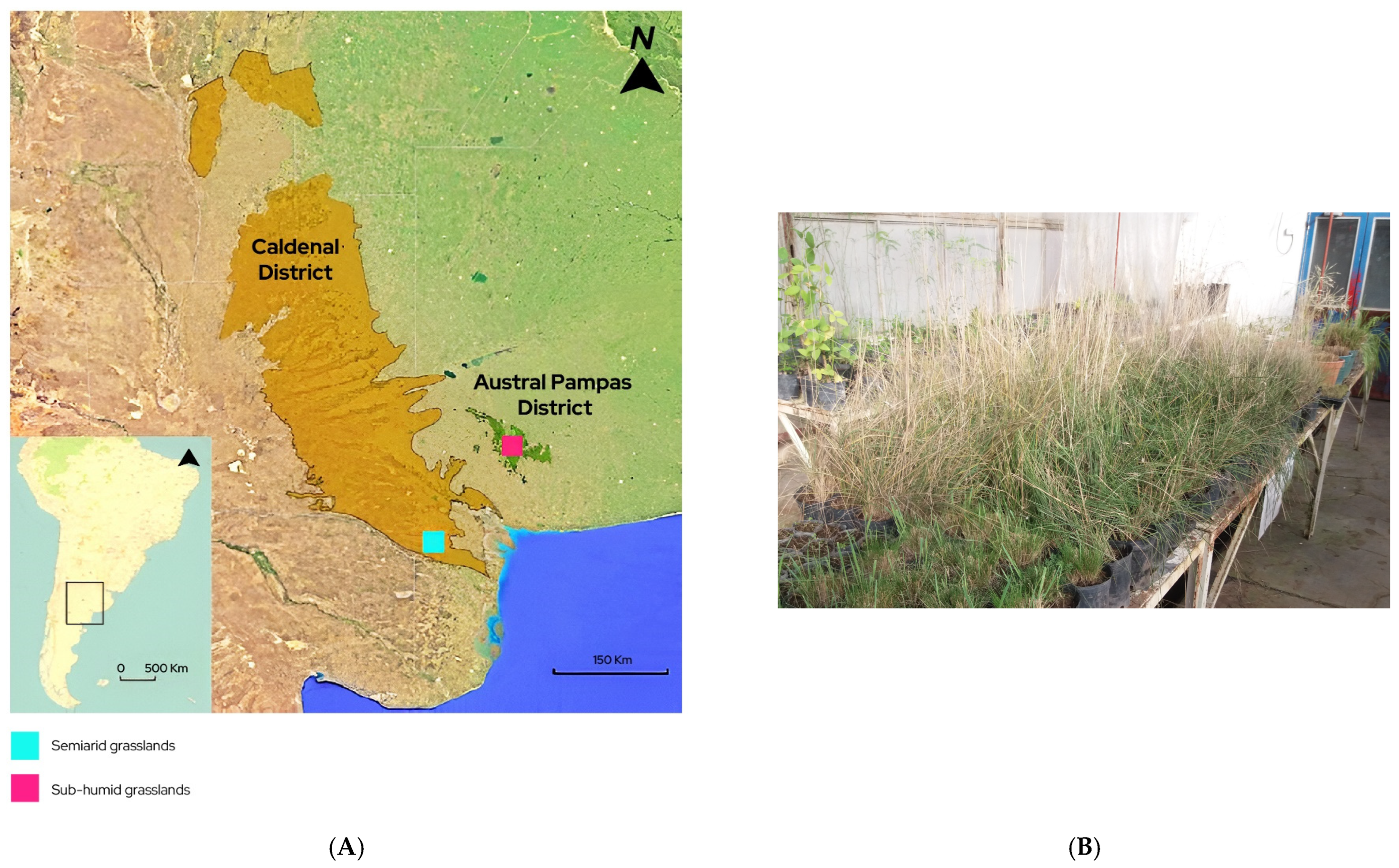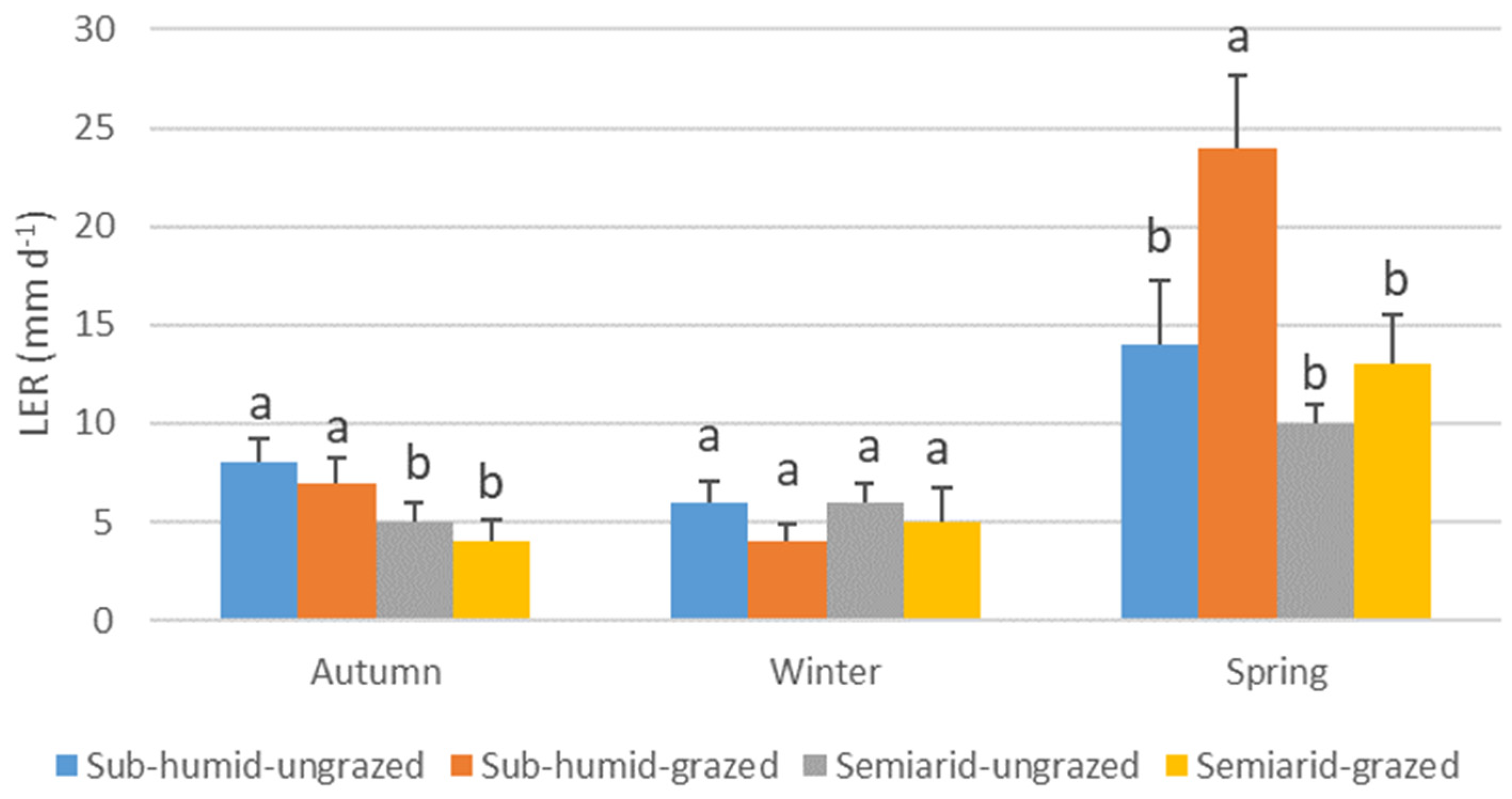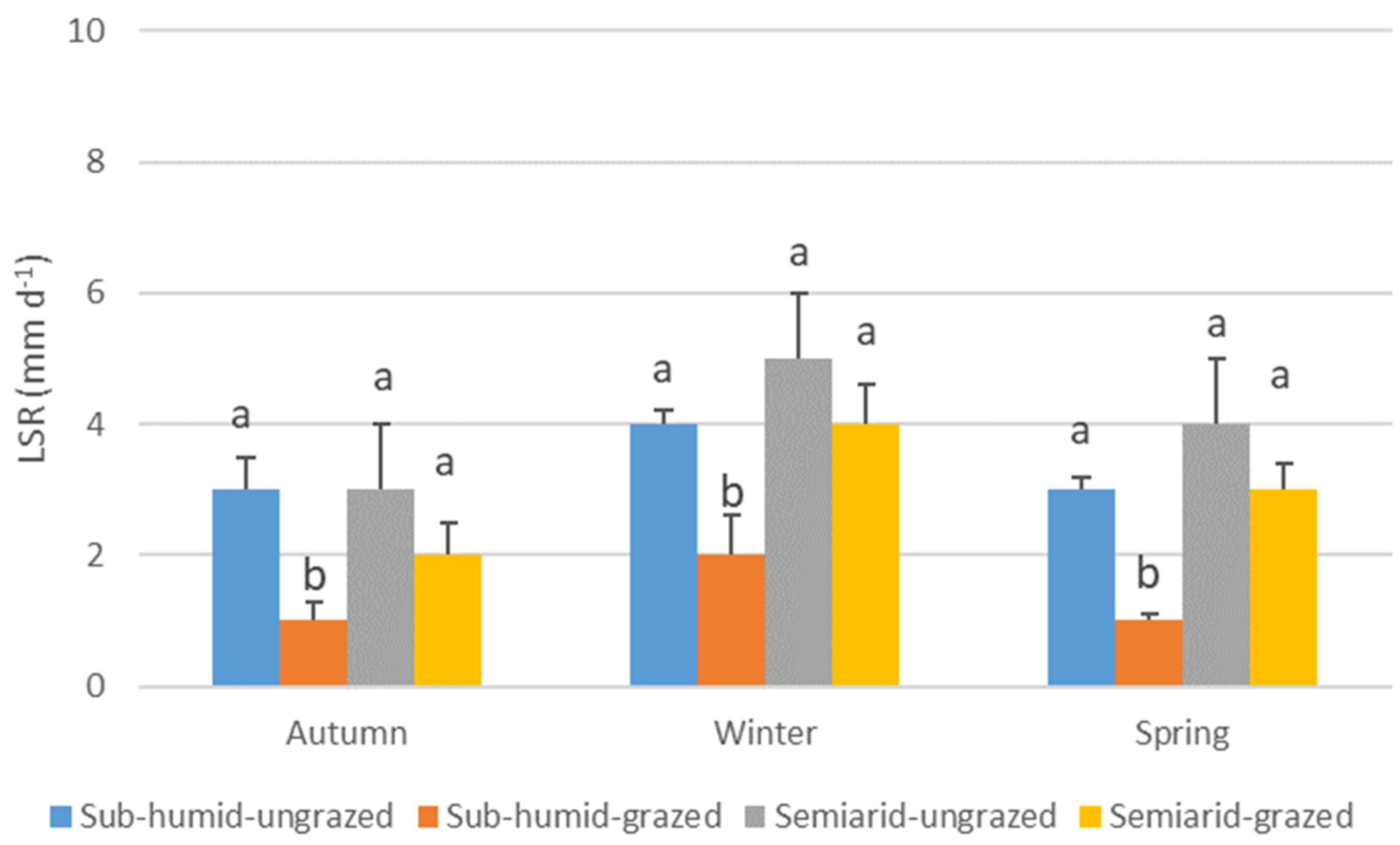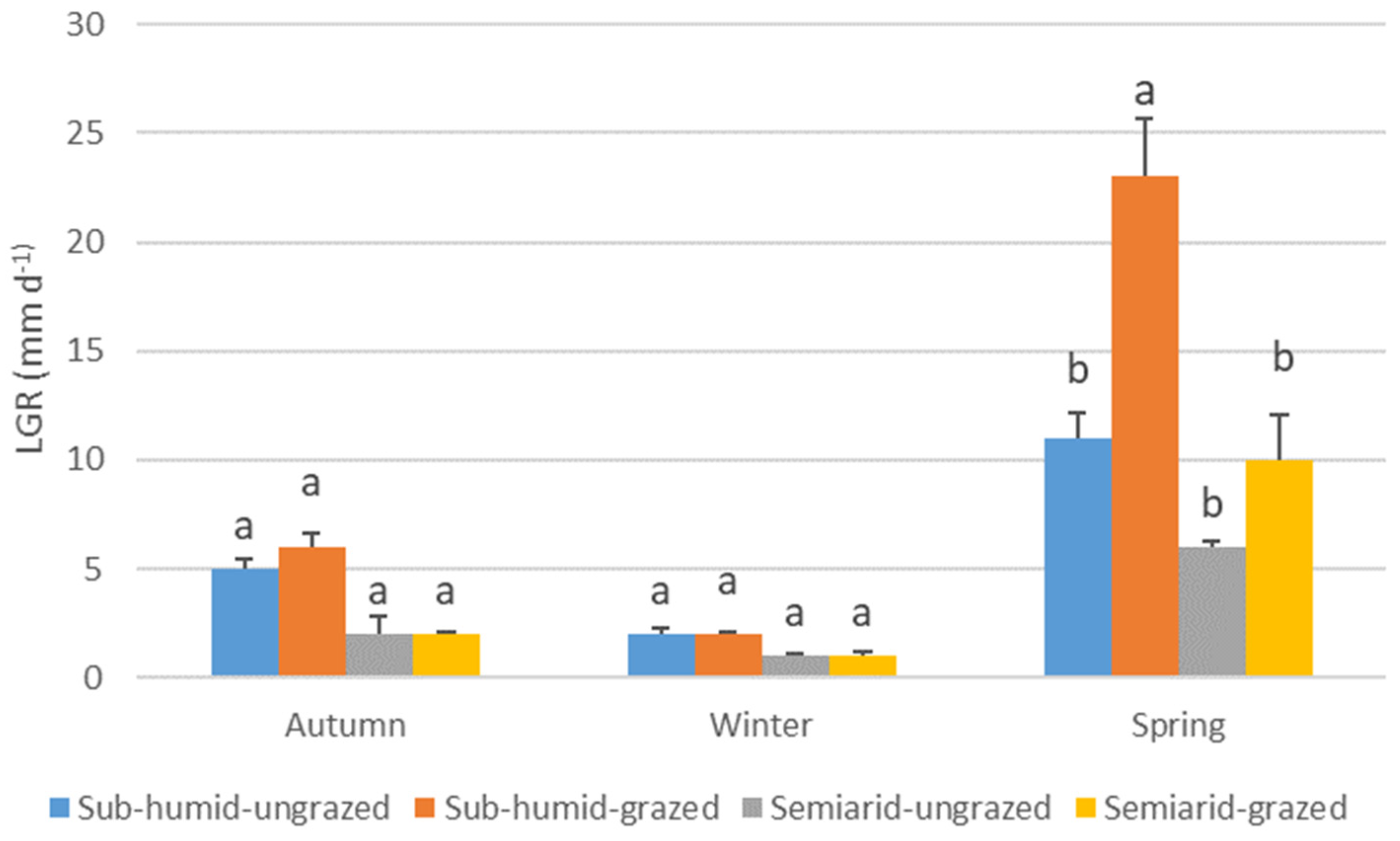Growth Dynamics of Nassella tenuis (Phil.) Barkworth, a Palatable Perennial Tussock Grass of Central Argentina: Effects of Water Regime and Grazing History
Abstract
1. Introduction
2. Materials and Methods
2.1. Study Site
2.2. Field Survey and Greenhouse Cultivation
2.3. Growth Rate Calculations and Data Analysis
3. Results
4. Discussion
4.1. Effects of Water Regime and Grazing History on Growth and Morphology
4.2. Functional Responses and Growth Trade-Offs Under Environmental Stress
4.3. Seasonal Growth Patterns and Plant Origin
4.4. Adaptive Strategies and Resource Allocation in Variable Environments
5. Conclusions
Supplementary Materials
Author Contributions
Funding
Data Availability Statement
Acknowledgments
Conflicts of Interest
References
- Thomas, T.W.; Davies, K.W.; Mata-Gonzalez, R.; Svejcar, L.N.; Clenet, D. Effects of a decade of grazing exclusion on three Wyoming big sagebrush community types. Glob. Ecol. Conserv. 2022, 40, e02338. [Google Scholar] [CrossRef]
- Aphalo, P.J.; Sadras, V.O. Explaining pre-emptive acclimation by linking information to plant phenotype. J. Exp. Bot. 2022, 73, 5213–5234. [Google Scholar] [CrossRef]
- Zhu, J.K. Abiotic stress signaling and responses in plants. Cell 2016, 167, 313–324. [Google Scholar] [CrossRef]
- Trewavas, A. What is plant behaviour? Plant Cell Environ. 2009, 32, 606–616. [Google Scholar] [CrossRef] [PubMed]
- Karban, R.; Orrock, J.L. A judgment and decision-making model for plant behavior. Ecology 2018, 99, 1909–1919. [Google Scholar] [CrossRef] [PubMed]
- Norton, M.R.; Malinowski, D.P.; Volaire, F. Plant drought survival under climate change and strategies to improve perennial grasses. A review. Agron. Sustain. Dev. 2016, 36, 29. [Google Scholar] [CrossRef]
- Volaire, F.; Morvan-Bertrand, A.; Prud’homme, M.-P.; Benot, M.-L.; Augusti, A.; Zwicke, M.; Roy, J.; Landais, D.; Picon-Cochard, C. The resilience of perennial grasses under two climate scenarios is correlated with carbohydrate metabolism in meristems. J. Exp. Bot. 2020, 71, 370–385. [Google Scholar] [CrossRef]
- Gauthier, M.; Barillot, R.; Andrieu, B. Simulating grass phenotypic plasticity as an emergent property of growth zone responses to carbon and nitrogen metabolites. In Silico Plants 2021, 3, diab034. [Google Scholar] [CrossRef]
- Cavallaro, A.; Carbonell-Silletta, L.; Askenazi, J.O.; Goldstein, G.; Bucci, S.J.; Scholz, F.G. Phenotypic plasticity in leaf traits in response to experimental precipitation increase: Wettability, foliar water uptake, and gas exchange. Ecohydrology 2023, 16, e2573. [Google Scholar] [CrossRef]
- Lemaire, G.; Agnusdei, M. Leaf tissue turnover and efficiency of herbage utilization. In Grassland Ecophysiology and Grazing Ecology; Lemaire, G., Hodgson, J., Moraes, A., Carvalho, P.C.F., Nabinger, C., Eds.; CABI Publishing: London, UK, 2000; pp. 265–288. Available online: https://www.cabidigitallibrary.org/doi/10.1079/9780851994529.0265 (accessed on 2 September 2024).
- Skarpe, C.; Hester, A.J. Plant traits, browsing and grazing herbivores, and vegetation dynamics. In The Ecology of Browsing and Grazing; Gordon, I.J., Prins, H.H.T., Eds.; Springer: Berlin, Germany, 2008; pp. 217–261. [Google Scholar] [CrossRef]
- Hendrickson, J.R.; Moffet, C. Forage systems for the temperate subhumid and semiarid areas. Agriculture 2020, 2, 387–405. [Google Scholar] [CrossRef]
- Bilenca, D.N.; Miñarro, F. Identification of Valuable Grassland Areas (AVPs) in the Pampas and Campos of Argentina, Uruguay, and Southern Brazil; Fundación Vida Silvestre Argentina: Buenos Aires, Argentina, 2004; pp. 1–323. [Google Scholar]
- Arana, M.D.; Natale, E.; Ferretti, N.; Romano, G.; Oggero, A.; Martínez, G.; Posadas, P.; Morrone, J. Biogeographic scheme of the Republic of Argentina. Opera Lilloana 2021, 56, 1–238. (In Spanish) [Google Scholar]
- INTA (Instituto Nacional de Tecnología Agropecuaria). AgroMet and AgroCultivos Reports. Available online: https://www.argentina.gob.ar/inta/informacion-agroclimatica/informes-agromet-y-agrocultivos (accessed on 20 December 2024). (In Spanish).
- Pizarro, J.B. The evolution of agricultural production in the Pampas during the second half of the 20th century. Rev. Interdiscip. Estud. Agrar. 2003, 18, 63–125. Available online: http://bibliotecadigital.econ.uba.ar/download/riea/riea_v18_n1_03.pdf (accessed on 2 September 2024). (In Spanish).
- SENASA. Bovines and Bubalines Primary Sector: Characterization of Cattle Stock. Available online: https://www.argentina.gob.ar/senasa/mercados-y-estadisticas/estadisticas/animalestadisticas/bovinos/bovinos-y-bubalinos-sector-primario (accessed on 2 September 2024).
- Estelrich, H.D.; Castaldo, A. Livestock receptivity and stocking rate in different micro-regions of La Pampa Province (Argentina) and its relation to rainfall. Semiárida. Rev. Fac. Agron. UN La Pampa 2014, 24, 7–19. (In Spanish) [Google Scholar]
- Duchini, P.G.; Guzatti, G.C.; Echeverria, J.R.; Américo, L.F.; Sbrissia, A.F. Experimental evidence that the perennial grass persistence pathway is linked to plant growth strategy. PLoS ONE 2018, 13, e0207360. [Google Scholar] [CrossRef] [PubMed]
- Barre, P.; Turner, L.B.; Escobar-Gutiérrez, A.J. Leaf length variation in perennial forage grasses. Agriculture 2015, 5, 682–696. [Google Scholar] [CrossRef]
- Gibson, D.J. Grasses & Grassland Ecology; Oxford University Press: New York, NY, USA, 2009; pp. 1–305. [Google Scholar]
- Díaz, S.; Lavorel, S.; McIntyre, S.; Falczuk, V.; Casanoves, F.; Milchunas, D.G.; Skarpe, C.; Rusch, G.; Sternberg, M.; Noy-Meir, I.; et al. Plant trait responses to grazing—A global synthesis. Glob. Change Biol. 2007, 13, 313–341. [Google Scholar] [CrossRef]
- da Silveira Pontes, L.; Maire, V.; Schellberg, J.; Louault, F. Grass strategies and grassland community responses to environmental drivers: A review. Agron. Sustain. Dev. 2015, 35, 1297–1318. [Google Scholar] [CrossRef]
- Joswig, J.S.; Wirth, C.; Schuman, M.C.; Kattge, J.; Reu, B.; Wright, I.J.; Sippel, S.D.; Rüger, N.; Richter, R.; Schaepman, M.E.; et al. Climatic and soil factors explain the two-dimensional spectrum of global plant trait variation. Nat. Ecol. Evol. 2022, 6, 36–50. [Google Scholar] [CrossRef]
- Wang, L.; Feng, S.-J.; Sun, D.; Wang, J.; Wang, Y.; Lee, S.-J.; Lu, P.; Gan, Y. Plant biotype interacting grazing activity shapes grassland ecosystem functions. Ecosphere 2023, 14, e4730. [Google Scholar] [CrossRef]
- Cabrera, A.L. Regiones Fitogeográficas Argentinas; Enciclopedia Argentina de Agricultura y Jardinería, Tomo II, Fascículo 1; Acme: Buenos Aires, Argentina, 1976; pp. 1–85. (In Spanish) [Google Scholar]
- Cialdella, A.M.; Muñoz-Schick, M.; Morrone, O. Synopsis of the Austro-American species of the genus Nassella (Poaceae, Pooideae, Stipeae). Darwiniana Nueva Ser. 2013, 1, 76–161. (In Spanish) [Google Scholar] [CrossRef]
- Distel, R.A.; Fernández, O.A. Productivity of Stipa tenuis Phil. and Piptochaetium napostaense (Speg.) Hack in semiarid Argentina. J. Arid Environ. 1986, 11, 93–96. [Google Scholar] [CrossRef]
- Distel, R.A.; Pietragalla, J.; Rodríguez Iglesias, R.M.; Didoné, N.G.; Andrioli, R.J. Restoration of palatable grasses: A study case in degraded rangelands of central Argentina. J. Arid Environ. 2008, 72, 1968–1972. [Google Scholar] [CrossRef]
- Busso, C.A.; Montenegro, O.A.; Torres, Y.A.; Giorgetti, H.D.; Rodriguez, G.D. The influence of disturbance type on precipitation-use efficiency at functional group and species scales in an arid habitat. Pol. J. Ecol. 2016, 64, 143–164. [Google Scholar] [CrossRef]
- Modernel, P.; Rossing, W.A.H.; Corbeels, M.; Dogliotti, S.; Picasso, V.; Tittonell, P. Land use change and ecosystem service provision in Pampas and Campos grasslands of southern South America. Environ. Res. Lett. 2016, 11, 113002. [Google Scholar] [CrossRef]
- Michalijos, M.P. Study of Forest Fire Risk in a Sector of the Sierra de la Ventana Region Using Geotechnologies; EdiUNS: Bahía Blanca, Argentina, 2019; pp. 1–120. (In Spanish) [Google Scholar]
- Long, M.A. Common and Rare Species in the Flora of the Southern Mountains of Buenos Aires: Historical, Ecological and Environmental Causes; EdiUNS: Bahía Blanca, Argentina, 2018; pp. 1–305. (In Spanish) [Google Scholar]
- Matteucci, S. Espinal Ecoregion. In Ecoregions and Ecosystem Complexes of Argentina; Morello, J., Matteucci, S., Rodríguez, A.F., Silva, M.E., Eds.; Orientación Gráfica Editora: Buenos Aires, Argentina, 2012; pp. 349–390. (In Spanish) [Google Scholar]
- de Villalobos, A.E.; Peláez, D.V. Functional responses of woody Prosopis caldenia seedlings to drought and livestock grazing in semiarid rangelands of Argentina. Arid Land Res. Manag. 2015, 29, 487–502. [Google Scholar] [CrossRef]
- de Villalobos, A.E.; Schwerdt, L. Seasonality of feral horse grazing and invasion of Pinus halepensis in grasslands of the Austral Pampean Mountains (Argentina): Management considerations. Biol. Invasions 2020, 22, 2941–2955. Available online: https://link.springer.com/article/10.1007/s10530-020-02300-x (accessed on 2 September 2024). [CrossRef]
- de Villalobos, A.E.; Long, M.A. Grasslands response to livestock grazing intensity in the Austral Pampas (Argentina): Testing the Intermediate Disturbance Hypothesis. Phyton-Int. J. Exp. Bot. 2024, 93, 2037–2050. [Google Scholar] [CrossRef]
- Carvalho, D.D.; Matthew, C.; Hodgson, J. Effect of aging in tillers of Panicum maximum on leaf elongation rate. In Proceedings of the International Grassland Congress; International Grassland Congress Organizing Committee, Ed.; International Grassland Congress: São Pedro, Brazil, 2001; pp. 41–42. [Google Scholar]
- Zar, J.H. Biostatistical Analysis; Prentice Hall: Oxford, UK, 2009; pp. 1–960. [Google Scholar]
- Fahnestock, J.T.; Detling, J.K. Bison–prairie dog–plant interactions in a North American mixed-grass prairie. Oecologia 2002, 132, 86–95. [Google Scholar] [CrossRef]
- Tomas, M.A.; Carrera, A.D.; Poverene, M. Is there any genetic differentiation among populations of Piptochaetium napostaense (Speg.) Hack (Poaceae) with different grazing histories? Plant Ecol. 2000, 147, 227–235. [Google Scholar] [CrossRef]
- Poorter, H.; Fiorani, F.; Pieruschka, R.; Wojciechowski, T.; van der Putten, W.H.; Kleyer, M.; Schurr, U.; Postma, J. Pampered inside, pestered outside? Differences and similarities between plants growing in controlled conditions and in the field. New Phytol. 2016, 212, 838–855. [Google Scholar] [CrossRef]
- Gonnet, J.M.; Guevara, J.C.; Estevez, O.R. Perennial grass abundance along a grazing gradient in Mendoza, Argentina. J. Range Manag. 2003, 56, 364–369. [Google Scholar] [CrossRef]
- Travers, S.; Berdugo, M. Grazing and productivity alter individual grass size dynamics in semiarid woodlands. Ecography 2020, 43, 1003–1013. [Google Scholar] [CrossRef]
- Utrilla, V.; Andrade, M.; Vargas, P.; Alsina, M.; Aguilar, R.; Galván, J. Pasture and grassland productivity and foliar elongation of wheatgrass in Southern Patagonia. Agrociencia Urug. 2023, 27, e993. [Google Scholar] [CrossRef]
- Noy-Meir, I. Compensating growth of grazed plants and its relevance to the use of rangelands. Ecol. Appl. 1993, 3, 32–34. [Google Scholar] [CrossRef]
- Cingolani, A.M.; Posse, G.; Collantes, M.B. Plant functional traits, herbivore selectivity and response to sheep grazing in Patagonian steppe grasslands. J. Appl. Ecol. 2005, 42, 50–59. [Google Scholar] [CrossRef]
- Zheng, S.; Li, W.; Lan, Z.; Ren, H.; Wang, K. Functional trait responses to grazing are mediated by soil moisture and plant functional group identity. Sci. Rep. 2015, 5, 18163. [Google Scholar] [CrossRef]
- Temu, V.W.; Kering, M.K. Compensatory structural growth responses of early-succession native warm-season grass stands to defoliation management. Agronomy 2023, 13, 1280. [Google Scholar] [CrossRef]
- Twine, W.; Gray, V.; Owen-Smith, N. The effect of prolonged heavy grazing pressure on the regrowth of two perennial grass species in a semiarid communal rangeland. Afr. J. Range Forage Sci. 2002, 19, 129–130. [Google Scholar] [CrossRef]
- Ye, R.; Liu, G.; Chang, H.; Shan, Y.; Mu, L.; Wen, C.; Te, R.; Wu, N.; Shi, L.; Liu, Y.; et al. Response of plant traits of Stipa breviflora to grazing intensity and fluctuation in annual precipitation in a desert steppe, northern China. Glob. Ecol. Conserv. 2020, 24, e01256. [Google Scholar] [CrossRef]
- Blumenthal, D.M.; Kray, J.A.; Mueller, K.E. Coordination of leaf, root, and seed traits shows substantial niche differentiation among herbaceous species in semiarid grasslands. New Phytol. 2024, 241, 2410–2422. [Google Scholar] [CrossRef]
- Munné-Bosch, S.; Alegre, L. Die and let live: Leaf senescence contributes to plant survival under drought stress. Funct. Plant Biol. 2004, 31, 203–216. [Google Scholar] [CrossRef] [PubMed]
- Yan, T.; Wang, L.; Wang, P.; Zhong, T. Stability in the leaf functional traits of understory herbaceous species after 12 years of nitrogen addition in temperate larch plantations. Front. Plant Sci. 2023, 14, 1282884. [Google Scholar] [CrossRef]
- Dwivedi, S.L.; Reynolds, M.P.; Ortiz, R. Mitigating tradeoffs in plant breeding. iScience 2021, 24, 102965. [Google Scholar] [CrossRef]
- Philippe, E.; Diquelou, S.; Prudent, M.; Salon, C.; Maillard, A.; Ourry, A. Macro and micronutrient storage in plants and their remobilization when facing scarcity: The case of drought. Agriculture 2018, 8, 14. [Google Scholar] [CrossRef]
- Grime, J.P. Evidence for existence of three primary strategies in plants and its relevance to ecological and evolutionary theory. Am. Nat. 1977, 111, 1169–1194. [Google Scholar] [CrossRef]
- Rouet, S.; Barillot, R.; Leclercq, D.; Bernicot, M.-H.; Combes, D.; Escobar-Gutiérrez, A.; Durand, J.-L. Interactions between environment and genetic diversity in perennial grass phenology: A review of processes at plant scale and modeling. Front. Plant Sci. 2021, 12, 672156. [Google Scholar] [CrossRef]
- Woledge, J.; Parsons, A.J. The effect of temperature on the photosynthesis of ryegrass canopies. Ann. Bot. 1986, 57, 487–497. [Google Scholar] [CrossRef]
- Förster, L.; Grant, J.; Michel, T.; Ng, C.; Barth, S. Growth under cold conditions in a wide perennial ryegrass panel is under tight physiological control. PeerJ 2018, 6, e5520. [Google Scholar] [CrossRef] [PubMed]
- Quiroga, R.E.; Golluscio, R.A.; Blanco, L.J.; Fernández, R.J. Aridity and grazing as convergent selective forces: An experiment with an Arid Chaco bunchgrass. Ecol. Appl. 2010, 20, 1876–1889. [Google Scholar] [CrossRef] [PubMed]
- Yang, J.; Udvardi, M. Senescence and nitrogen use efficiency in perennial grasses for forage and biofuel production. J. Exp. Bot. 2018, 69, 855–865. [Google Scholar] [CrossRef] [PubMed]
- Zhang, K.; Xie, H.; Wen, J.; Zhang, J.; Wang, Z.Y.; Chai, M. Leaf senescence in forage and turf grass: Progress and prospects. Grass Res. 2024, 4, e004. [Google Scholar] [CrossRef]
- Craine, J.M. Resource Strategies of Wild Plants; Princeton University Press: Princeton, NJ, USA, 2009; pp. 1–344. [Google Scholar]
- Colesie, C.; Stangl, Z.R.; Hurry, V. Differences in growth-economics of fast vs. slow growing grass species in response to temperature and nitrogen limitation individually, and in combination. BMC Ecol. 2020, 20, 63. [Google Scholar] [CrossRef] [PubMed]
- Keep, T.; Sampoux, J.; Barre, P.; Blanco-Pastor, J.; Dehmer, K.J.; Durand, J.; Hegarty, M.; Ledauphin, T.; Muylle, H.; Roldán-Ruiz, I.; et al. To grow or survive: Which are the strategies of a perennial grass to face severe seasonal stress? Funct. Ecol. 2021, 35, 1145–1158. [Google Scholar] [CrossRef]




| Water Regime | Grazing History | Interaction | ||||
|---|---|---|---|---|---|---|
| Variables | F | p | F | p | F | p |
| Diameter (cm) | 21.72 | <0.001 | 206.24 | <0.001 | 30.51 | <0.001 |
| Height (cm) | 1.98 | 0.170 | 31.80 | <0.001 | 32.01 | <0.001 |
| Vegetative tillers (number) | 14.61 | <0.001 | 124.80 | <0.001 | 0.02 | 0.897 |
| Flowering tillers (number) | 28.20 | <0.001 | 244.91 | <0.001 | 0.50 | 0.122 |
| LER (annual average) | 36.92 | <0.001 | 7.23 | 0.100 | 3.58 | 0.066 |
| LSR (annual average) | 9.62 | 0.004 | 11.36 | 0.002 | 0.45 | 0.504 |
| LGR (annual average) | 101.48 | <0.001 | 32.96 | <0.001 | 14.37 | <0.001 |
| Ungrazed | Grazed | |||||||
|---|---|---|---|---|---|---|---|---|
| Sub-Humid | Semiarid | F | p | Sub-Humid | Semiarid | F | p | |
| Diameter (cm) | 25.3 ± 3.3 | 26.1 ± 2.2 | 1.75 | 0.540 | 17.1 ± 3.3 | 7.17 ± 2.3 | 7.68 | <0.001 |
| Height (cm) | 27.6 ± 2.2 | 31.2 ± 3.0 | 1.47 | 0.244 | 26.7 ± 2.2 | 21.6 ± 3.2 | 5.87 | 0.038 |
| LGR (annual average) | 40.0 ± 5.1 | 34.7 ± 6.3 | 2.10 | 0.065 | 20.0 ± 3.0 | 10.2 ± 2.4 | 8.10 | <0.001 |
| LER (mm d−1) | LSR (mm d−1) | LGR (mm d−1) | Flowering Tillers (Number) | ||
|---|---|---|---|---|---|
| Sub-humid-Ungrazed | Diameter | 0.87 | 0.90 | 0.96 | 0.89 |
| Height | −0.57 | −0.55 | −0.81 | −0.56 | |
| Tillers | 0.94 | 0.95 | 0.85 | 0.99 | |
| Sub-humid-Grazed | Diameter | −0.97 | −0.90 | −0.98 | 0.99 |
| Height | −0.80 | −0.80 | −0.75 | 0.69 | |
| Tillers | −0.93 | −0.85 | −0.95 | 0.97 | |
| Semiarid-Ungrazed | Diameter | −0.94 | 0.94 | −0.95 | 0.95 |
| Height | −0.94 | 0.83 | −0.85 | 0.83 | |
| Tillers | −0.95 | 0.96 | −0.94 | 0.93 | |
| Semiarid-Grazed | Diameter | 0.97 | −0.93 | 0.96 | −0.34 |
| Height | 0.58 | −0.46 | 0.58 | 0.29 | |
| Tillers | 0.95 | −0.97 | 0.95 | −0.27 | |
| Autumn | Winter | Spring | ||||
|---|---|---|---|---|---|---|
| F | p | F | p | F | p | |
| LER (mm d−1) | 17.30 | 0.0003 | 1.70 | 0.2347 | 35.01 | 1.948 × 10−5 |
| LSR (mm d−1) | 7.20 | 0.0041 | 12.30 | 0.0009 | 15.21 | 0.0004 |
| LGR (mm d−1) | 1.12 | 0.4480 | 1.31 | 0.3597 | 20.80 | 0.0002 |
Disclaimer/Publisher’s Note: The statements, opinions and data contained in all publications are solely those of the individual author(s) and contributor(s) and not of MDPI and/or the editor(s). MDPI and/or the editor(s) disclaim responsibility for any injury to people or property resulting from any ideas, methods, instructions or products referred to in the content. |
© 2025 by the authors. Licensee MDPI, Basel, Switzerland. This article is an open access article distributed under the terms and conditions of the Creative Commons Attribution (CC BY) license (https://creativecommons.org/licenses/by/4.0/).
Share and Cite
de Villalobos, A.E.; Ribet, A.; Vivas, S.; Schwerdt, L. Growth Dynamics of Nassella tenuis (Phil.) Barkworth, a Palatable Perennial Tussock Grass of Central Argentina: Effects of Water Regime and Grazing History. Grasses 2025, 4, 35. https://doi.org/10.3390/grasses4030035
de Villalobos AE, Ribet A, Vivas S, Schwerdt L. Growth Dynamics of Nassella tenuis (Phil.) Barkworth, a Palatable Perennial Tussock Grass of Central Argentina: Effects of Water Regime and Grazing History. Grasses. 2025; 4(3):35. https://doi.org/10.3390/grasses4030035
Chicago/Turabian Stylede Villalobos, Ana E., Alejandro Ribet, Sofía Vivas, and Leonela Schwerdt. 2025. "Growth Dynamics of Nassella tenuis (Phil.) Barkworth, a Palatable Perennial Tussock Grass of Central Argentina: Effects of Water Regime and Grazing History" Grasses 4, no. 3: 35. https://doi.org/10.3390/grasses4030035
APA Stylede Villalobos, A. E., Ribet, A., Vivas, S., & Schwerdt, L. (2025). Growth Dynamics of Nassella tenuis (Phil.) Barkworth, a Palatable Perennial Tussock Grass of Central Argentina: Effects of Water Regime and Grazing History. Grasses, 4(3), 35. https://doi.org/10.3390/grasses4030035






